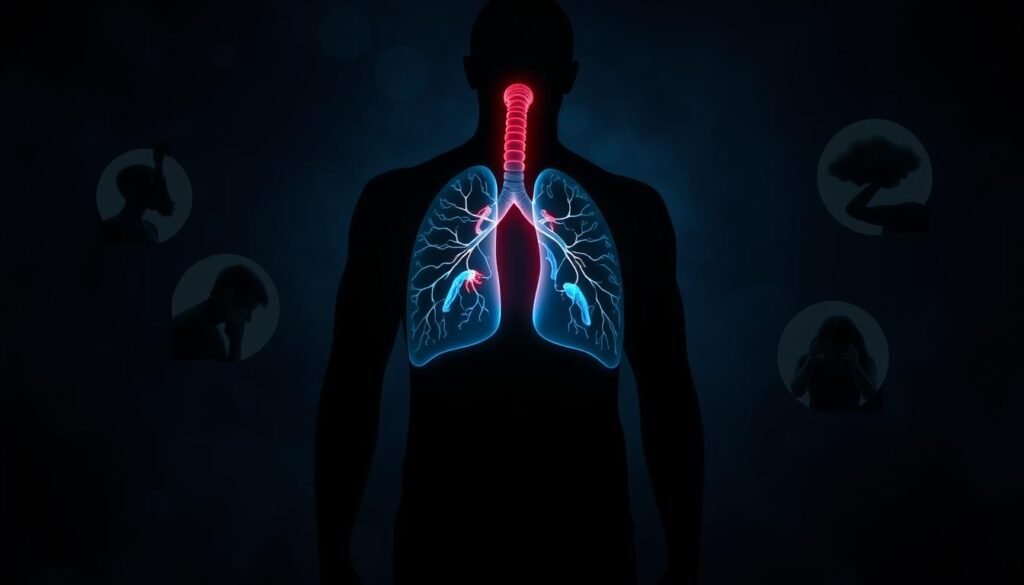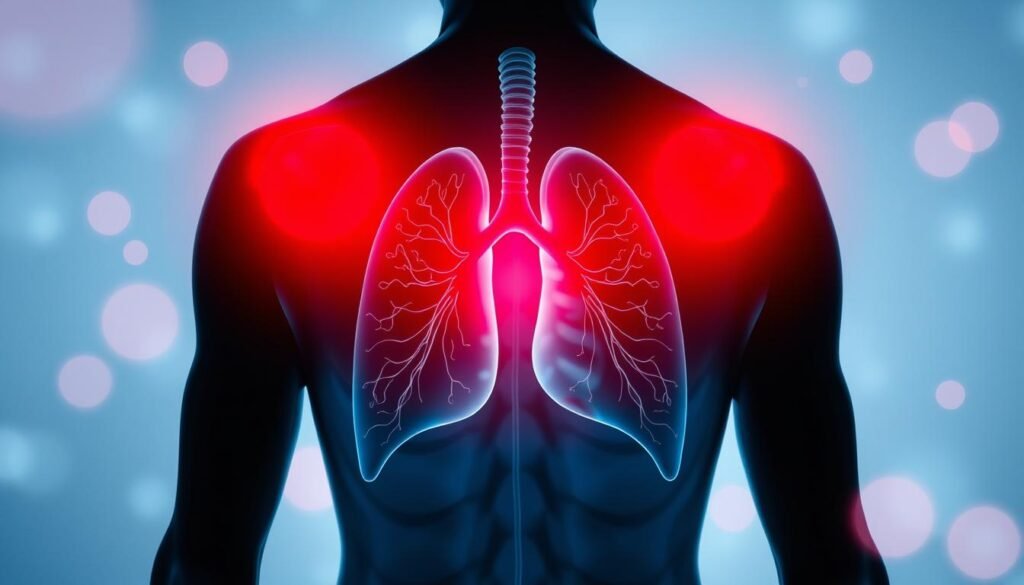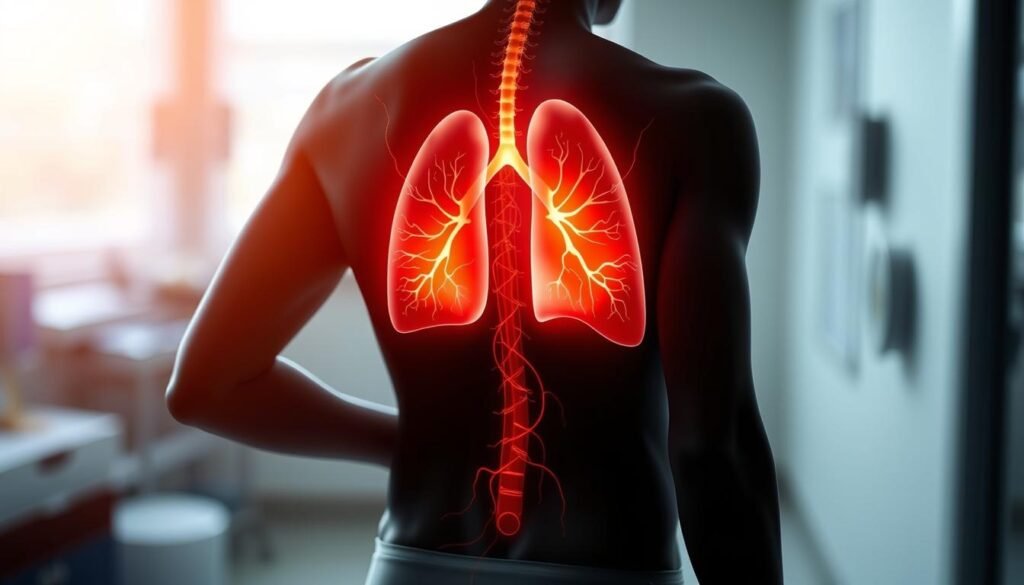Did you know that lung cancer deaths are mostly caused by smoking? It’s 80% for women and 90% for men. This shows why we need to be aware of lung cancer and its signs. Often, people think back pain comes from muscle issues or arthritis. But, it’s important to know that back pain can also mean lung cancer. In fact, many have found back pain to be their first lung cancer symptom.
This pain can show up before more known signs of lung cancer. Knowing about back pain linked to lung cancer helps catch the disease early. Early detection means better chances for successful treatment. For extra information, visit scarring and inflammation in lung cancer.
Key Takeaways
- Back pain warning signs can be associated with lung cancer, often overlooked.
- Early recognition of symptoms is key to improving treatment outcomes.
- Linking back pain with lung cancer can enhance overall lung cancer awareness.
- Many individuals, like Heather, experience back pain as an early symptom of lung cancer.
- Understanding the connection between back pain and lung cancer can lead to prompt medical attention.
Understanding Back Pain
Many people suffer from back pain, leading to discomfort and changes in how they live. It’s important to find out why back pain happens. This can be due to many reasons. Knowing these reasons helps people manage their pain better and find the right treatment.
Common Causes of Back Pain
Back pain can come from everyday actions, injuries, or health problems. Some common causes are:
- Muscle injuries or strains often occur due to improper lifting or sudden movements.
- Degenerative disc disease results from wear and tear on spinal discs, leading to discomfort.
- Kidney stones or infections can manifest as back pain, particularly in the lower back.
- Arthritis contributes to stiffer joints, causing pain in the back or neck.
- Lifestyle factors like poor posture, aging, and lack of physical activity significantly contribute to ongoing back issues.
Sometimes, lung cancer symptoms can cause back pain. This is especially true for those in the advanced stages. About 1 in 4 people with lung cancer report back pain. This is often due to tumor pressure or nerve issues.
When to Seek Medical Attention
Knowing when to see a doctor for back pain is crucial. You should get help if:
- Back pain persists or intensifies over six weeks.
- Pain worsens at night, disrupting sleep.
- Unexplained weight loss accompanies back pain.
- Neurological symptoms, such as muscle weakness or numbness, occur.
A quick check-up can reveal if back pain is from a severe issue like lung cancer or spinal cord problems. This means getting the right treatment fast.
Lung Cancer and Its Symptoms
Lung cancer shows different symptoms in different people. Noticing these signs early can help fight the cancer successfully. About 50% of people with lung cancer have a persistent cough. Other common signs include coughing up blood, losing weight without trying, and feeling very tired. Back pain and lung cancer might not seem linked at first. But, as the disease gets worse, they can become connected.
Common Symptoms of Lung Cancer
- Persistent cough: Seen in nearly 50% of patients.
- Coughing up blood: A concern for about 20% of individuals with lung cancer.
- Unintentional weight loss: Influencing 35% to 75% of patients before diagnosis.
- Fatigue: A frequently reported symptom among those diagnosed.
- Back pain: Affects about 25% of lung cancer patients and can indicate more serious issues.
How Lung Cancer Differs from Other Conditions
Lung cancer symptoms can be similar to other health problems, making it hard to diagnose. A cough that doesn’t go away could be from pneumonia or bronchitis too. If someone has both back pain and lung cancer, it might mean the cancer is growing, especially if it spreads to the bones. It’s very important to see a doctor for a correct diagnosis when symptoms are worrying.

| Symptom | Frequency | Significance |
|---|---|---|
| Persistent cough | 50% | Most common symptom |
| Coughing up blood | 20% | Possible indication of advanced disease |
| Unintentional weight loss | 35-75% | Red flag before diagnosis |
| Back pain | 25% | May signify metastasis |
Lung Cancer Symptoms Back Pain: What to Look For
It’s important to know how back pain and lung cancer are connected for early lung cancer detection. If you have unexplained back pain, pay attention to its details. Signs might point to lung cancer, so watch out for these:
- Persistent back pain at rest could be a red flag.
- Notice if the pain gets worse at night or when taking deep breaths.
- Look out for chronic cough, feeling very tired, and coughing up blood as additional back pain symptoms.
Finding these symptoms early can help with treatment. For instance, one patient with stage 4 lung cancer first noticed back pain. Lung cancer symptoms back pain varies from person to person. While some feel pain primarily, others might notice wheezing, trouble breathing, or losing weight.
If your back pain doesn’t go away and you also have trouble breathing or other strange symptoms, see a doctor right away. Getting help early can really increase the chance of successful treatment and a better life.

How Lung Cancer Causes Back Pain
Lung cancer can lead to back pain through the growth of tumors. These tumors put pressure on your back, causing discomfort. It’s different than the usual muscular pain. It’s important to know lung cancer can cause specific types of back pain.
Direct Pressure from Tumors
Tumors could grow large and press on tissues, organs, and spine areas. More than 25% of lung cancer patients feel back pain from this. The pain might be sharp or dull due to tumors pressing on the spine. It can even cause serious issues like vertebral fractures or the need for specific radiotherapy treatments. Imaging tests like CT scans or MRIs can show if a tumor is causing the pain.
Nerve Irritation and Damage
Tumors can also damage nerves, leading to pain, tingling, or other sensations. This is common in 30% to 40% of non-small cell lung cancer patients, especially if the cancer spreads to the bones. It could cause issues like lumbosacral radiculopathy due to nerve compression. Knowing these causes is crucial for managing symptoms. For more on lung cancer back pain, check out this detailed resource.

| Condition | Estimated Incidence | Potential Symptoms |
|---|---|---|
| Bone Metastasis | 30% to 40% | Back pain, fractures |
| Leptomeningeal Metastasis | 1% to 5% | Back pain, nerve-related symptoms |
| General Back Pain in Lung Cancer | About 25% | Sharp or aching pain |
Recognizing the Signs of Lung Cancer-Related Back Pain
Understanding the difference between lung cancer pain and other back pains is key. Lung cancer back pain has unique signs. Knowing these signs helps spot cancer pain early on.
Distinguishing Features of Cancer Pain
It’s crucial to know how cancer pain feels for early treatment. Lung cancer back pain might show as:
- Disruptive pain: Pain that keeps you awake might mean a deeper problem.
- Pain severity: Sharp pain or pain that gets worse when you’re still could point to cancer.
- Location: Pain with lung cancer signs like coughing or weird breath sounds is a red flag.
Associated Symptoms to Monitor
Watching out for other lung cancer signs with back pain is essential. Important symptoms include:
- A cough that doesn’t go away.
- Unexplained weight loss or less appetite.
- Hard time breathing, seen in many lung cancer cases.
If back pain comes with these symptoms, it’s time to see a doctor. Doctors can tell if it’s just back pain or if it’s lung cancer. Catching it early can change the treatment success. For more info on early signs and why quick help matters, check this reliable source.
Lung Cancer Back Pain Causes
It’s vital to know why lung cancer patients often suffer from back pain. Severe discomfort can arise from conditions like lung cancer spinal metastasis and bone metastasis. Understanding these can help in creating effective treatment plans.
Spinal and Bone Metastasis
Lung cancer frequently spreads to bones, contributing to back pain. Many patients, about 25%, report back pain as a symptom, sometimes before they even know they have cancer. The spine is a common spot for this spread, affecting 30 to 70 percent of patients with cancer. This can press on the spine, causing pain, neck discomfort, and other symptoms.
Bone metastasis from lung cancer may lead to high calcium levels in the blood. This is called hypercalcemia. It causes nausea, weakness, thirst, and severe back pain. Spinal cord pressure from these tumors can make it hard to move and lower one’s quality of life significantly.
Leptomeningeal Metastasis
Leptomeningeal metastasis is when cancer reaches the membranes around the brain and spinal cord. It can cause back pain along with neurological issues like headaches, muscle weakness, and coordination problems. While it’s rarer, it’s serious because of the risks it poses to lung cancer patients.
Diagnosing Back Pain from Lung Cancer
Finding out if back pain is linked to lung cancer needs careful checking. Doctors use many medical tests to get a full understanding. Knowing how these tests help is key to catching lung cancer early.
Medical Tests and Imaging
Lung cancer tests are crucial for diagnosing back pain from the disease. MRI and CT scans show the spine in detail. They can spot cancer lesions that press on nerves. Blood tests check for high calcium levels, indicating bone metastasis. It’s important to catch these signs early for effective treatment.
Importance of Early Diagnosis
Catching lung cancer early is very important, especially when back pain is a symptom. About 25% of people with lung cancer have back pain first. If diagnosis is delayed, treatments might not work as well. Finding and treating lung cancer early can make a big difference.
Lung Cancer Back Pain Treatment Options
Treating back pain due to lung cancer needs a mix of medical and alternative methods. Doctors often use painkillers and steroids to help with the pain. They might also use radiation therapy to focus on tumors causing pain. Also, medications like bisphosphonates help those with cancer spread to bones. These treatments improve life quality for lung cancer patients dealing with back pain.
Medical Treatment Approaches
Chemotherapy and targeted therapies are key in treating lung cancer. Chemotherapy shrinks tumors, and immunotherapy boosts the body’s fight against cancer. Surgery or radiation might be options if the cancer hasn’t spread much. Each patient gets a treatment plan suited to their needs. Finding the cancer early helps doctors decide on the best treatment. More on this is available in this resource.
Alternative Treatment Methods
Alternative therapies like acupuncture and physical therapy complement medical treatments. They aim to manage symptoms and improve life quality. Physical therapy, in particular, helps patients move better and feel less pain. It’s crucial to discuss palliative care options too. This care helps with physical and emotional issues from lung cancer. Combining different therapies offers a well-rounded support system for patients.